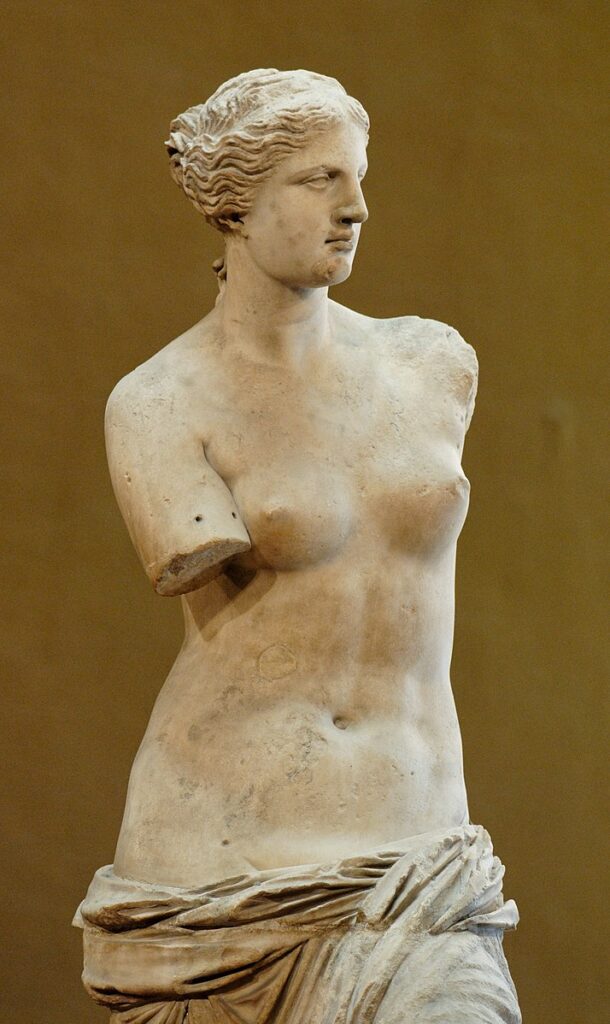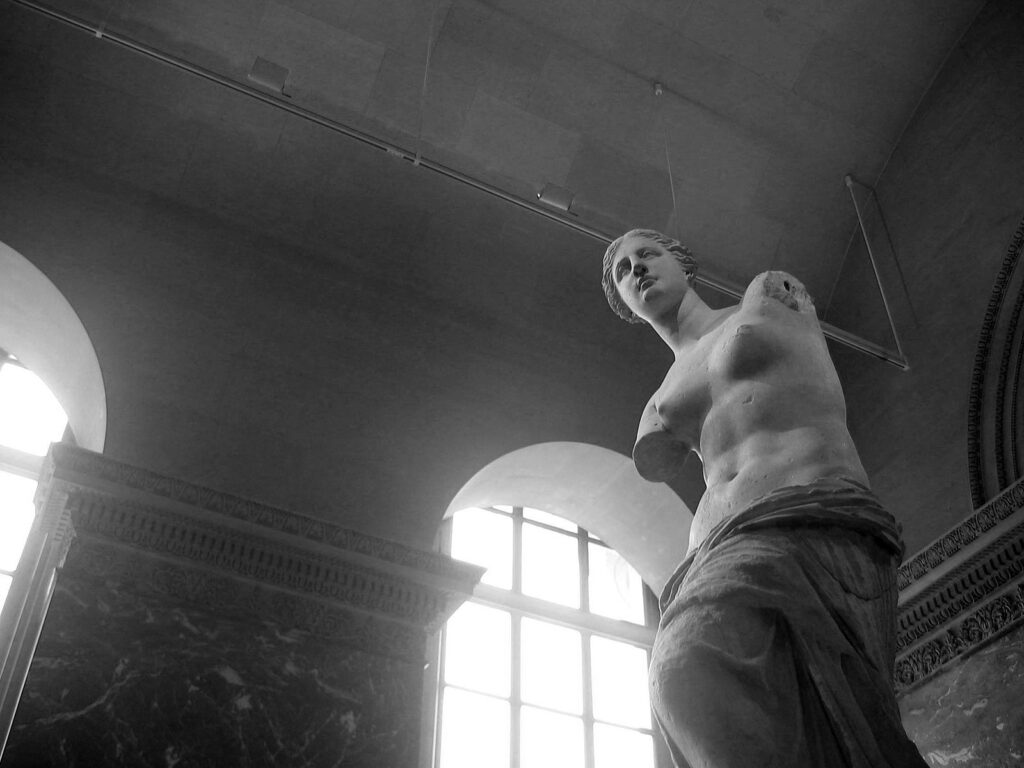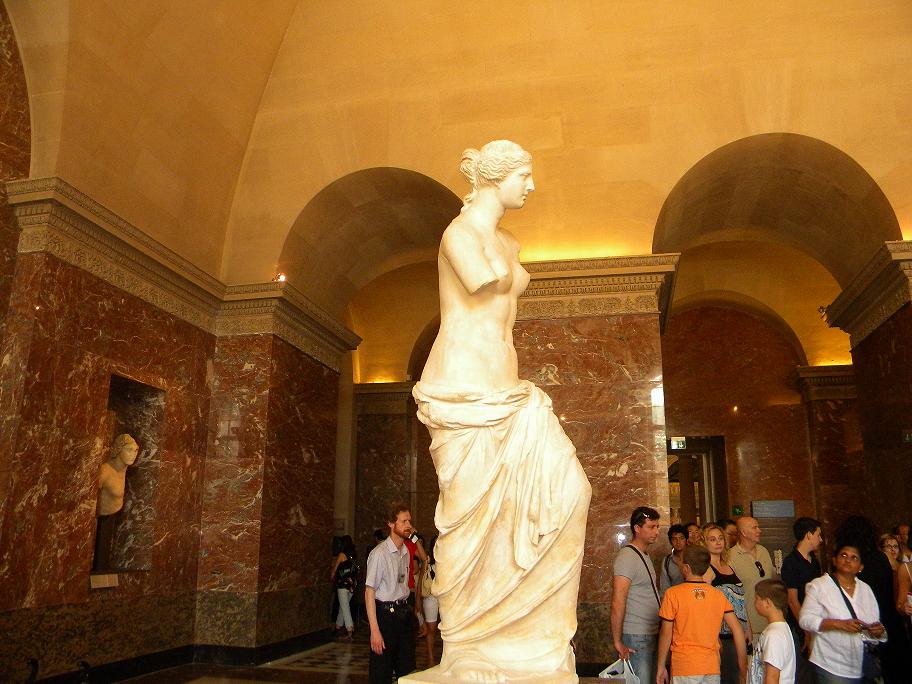In the pantheon of classical sculptures, few figures captivate the imagination quite like the Venus de Milo. This ancient masterpiece, renowned for its divine beauty, continues to intrigue art lovers and scholars alike centuries after its creation.
But the beautiful statue has a long history, filled with secrets and subterfuge that is not evident at first glance.

The Iconic Figure
Standing at just over six feet tall, the Venus de Milo is a marble statue. It depicts a female figure believed to represent the goddess Venus, the Roman equivalent of the Greek god Aphrodite.
Carved from Parian marble, the sculpture embodies the timeless ideals of classical beauty. She has a curving body that is perfect, save the missing arms.
The Venus de Milo is celebrated for its masterful craftsmanship and exquisite detailing. From the intricate folds of her garment to the delicate curvature of her limbs, every aspect of the sculpture reflects the skill and artistry of its creator, carving an impressive and smooth figure from a block by hand.
Despite the absence of her arms, which were lost to the ravages of time, the Venus de Milo exudes a sense of elegance and poise that continues to captivate viewers to this day.
Discovery and Acquisition
The story of the Venus de Milo begins in 1820 on the Greek island of Milos (also known as Melos). This is where a local farmer stumbled upon the statue while digging in his field.
A French sailor witnessed the farmer’s discovery. He encouraged him to keep digging and eventually enlisted French naval forces to help with the excavation.
With the end of the Napoleonic wars seeing the Louvre emptied, as artifacts stolen during conquest were returned to their rightful homes, the Louvre was desperate for new artwork.
Although the farmer sold to a buyer in Constantinople, French officials quickly purchased the statue from the farmer. They purchased it for today’s equivalent of $11,000.
They overwrote the agreement to take legal ownership of the statue. It quickly became a centerpiece of the museum, replacing an Italian statue of Venus the museum had recently returned.
It was originally marketed as a statue from antiquity. It was a relic from the golden age of Greece and Rome, which the French people held a particular love for at the time.
It was quickly discovered though that the state was actually Hellenistic. It was created in the first century BCE rather than in ancient Greece.
In fear of losing its reinvigorated audience, the museum hid any evidence of the statue’s true identity for over a century. This included a plinth that came with the statue stating its creation date, title, and sculptor, Alexandros of Antioch.
When it was finally revealed in the 1950s that the statue was not as ancient as originally believed, the work was already beloved by the nation and had become a national symbol.

Interpretations and Symbolism
From the moment of its discovery, the Venus de Milo has sparked endless speculation and debate among scholars and art enthusiasts.
While the sculpture is commonly identified as Venus, the Roman equivalent of the Greek Aphrodite, the precise meaning and symbolism behind the figure remain open to interpretation.
Some scholars have interpreted the Venus de Milo as a representation of idealized beauty and femininity. They say that it embodies the classical ideals of harmony, proportion, and grace.
Others have suggested that the statue may have served a religious or ceremonial purpose, perhaps as a cult image of the goddess Aphrodite, Other believe it could be a statue of Amphitrite, a sea-goddess associated with Poseidon, who also had a statue on Milos in the same era.
The Mystery of the Missing Arms
One of the most enduring mysteries surrounding the Venus de Milo is the absence of her arms.
Some scholars believe that the sculpture originally held symbolic objects such as a mirror, apple, or shield. Others speculate that the missing arms may have been deliberately removed or lost over time.
But scholars only have theories as the true reason for the Venus de Milo’s missing arms. It remains a subject of speculation and intrigue.
Some scholars argue that the absence of her arms only adds to the sculpture’s mystique. This invites viewers to engage with the figure on a deeper, more personal level.

Legacy and Influence
Since its arrival in Paris, the Venus de Milo has exerted a profound influence on art, culture, and popular imagination.
Countless artists, writers, and thinkers have drawn inspiration from the sculpture. Many incorporate its imagery and symbolism into their work.
The Venus de Milo’s enduring popularity, even in spite of the Louvre’s misdirection for a century, is a testament to its timeless beauty and universal appeal.
From its graceful form to its enigmatic expression, the sculpture continues to captivate audiences around the world. It invites us to ponder the mysteries of beauty, art, and human creativity.
Even as a popular symbol of France, the Venus de Milo cannot avoid the rising decolonial movement in the art world. In recent years, there have been calls from the people of Milos to return the statue to its rightful home on the island where it was found, although there has been little traction.
It is unlikely the Louvre will want to remove one of its most famous works. Especially one that has come to represent the country as a whole.
Conclusion
As we contemplate the Venus de Milo, we are reminded of the enduring power of art to transcend time and space. Art like this evokes emotions and sparks imaginations across generations.
From its humble origins on a Greek island to its current status as a global icon of beauty and mystery, the Venus de Milo stands as a testament to the enduring legacy of classical sculpture and the timeless ideals of beauty, grace, and harmony.
References
Grout, James. “Venus de Milo.” Encyclopedia Romana, November 21, 2023. https://penelope.uchicago.edu/~grout/encyclopaedia_romana/miscellanea/venus/venusdemilo.html.
Lesso, Rosie. “Why Is the Venus de Milo So Famous?” The Collector, November 4, 2022. https://www.thecollector.com/why-is-the-venus-de-milo-so-famous/.